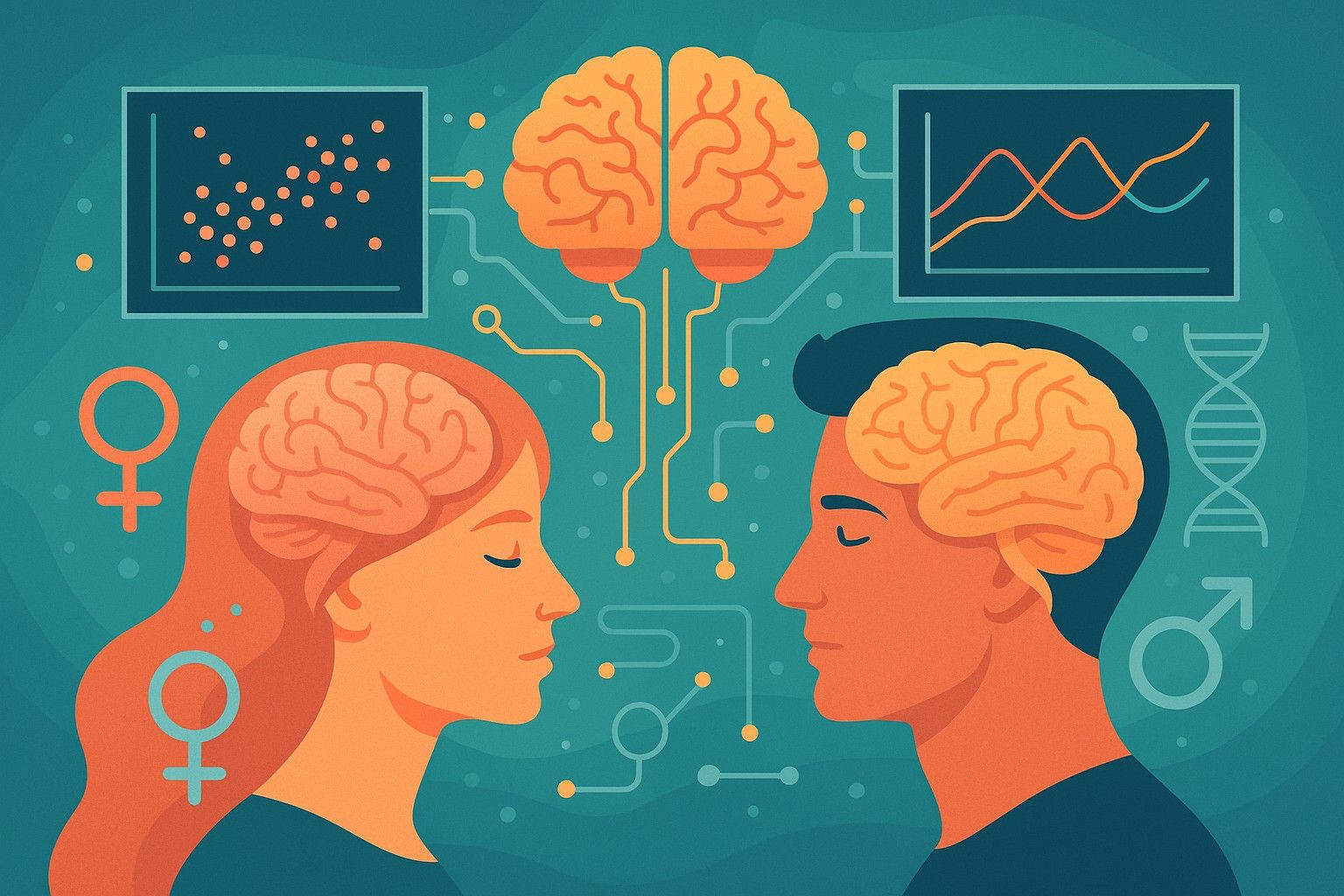Introduction
For centuries, scientists, philosophers, and medical professionals have debated whether there are inherent differences between male and female brains. The question has taken many forms: Are men naturally better at math? Are women biologically more empathetic? Recent advances in neuroscience are shedding new light on this complex and controversial topic, revealing measurable differences in brain structure and function between sexes. However, the implications of these differences are nuanced and continue to fuel important discussions about gender, equality, and biology.
In this report, we explore findings presented in Stanford Medicine’s article “How Men’s and Women’s Brains Are Different” and place them in context with broader scientific discourse. Our goal is to examine what these brain differences are, how they affect cognition and behavior, and why understanding them is both scientifically and socially significant.
A Brief History: From Gender Myths to Scientific Inquiry
Historically, the idea of brain differences between men and women was often used to justify social inequalities. In the 19th and early 20th centuries, pseudoscientific claims about brain size and structure were invoked to argue for male intellectual superiority. However, modern neuroscience has moved beyond such reductive views.
The new generation of research uses functional MRI (fMRI), positron emission tomography (PET), and molecular biology to explore how male and female brains differ—not in value or intelligence, but in structure, chemistry, and function. According to Stanford Medicine, these differences are subtle, often overlapping, and should not be used to reinforce stereotypes. Instead, they offer a more accurate understanding of the human brain.
Key Structural Differences Between Male and Female Brains
One of the most well-documented findings in neuroscience is the variation in brain volume between the sexes. On average, men have larger brains than women—about 11% larger—but this is proportional to body size and does not correlate with intelligence. When researchers control for size, a more complex and interesting picture emerges.
The Hippocampus
The hippocampus, a brain region critical for memory and learning, tends to be larger in women. Studies have linked this to superior performance in memory tasks, particularly those involving verbal information. This could partly explain why women, on average, excel in language-based assessments during childhood and adolescence.
The Amygdala
In contrast, men often have a larger amygdala, a region associated with processing emotions, aggression, and fear. However, this doesn’t mean men are more emotional—research suggests they might process emotional stimuli differently. Men, for example, tend to show more activation in the right amygdala, associated with immediate, action-oriented responses, while women show more activity in the left, linked to more detailed emotional processing.
White Matter vs. Gray Matter
Gender-based differences are also found in the proportion of gray and white matter. Gray matter contains most of the brain’s neuronal cell bodies and is linked with processing and cognition. White matter, composed of axonal connections, facilitates communication between brain regions.
Men typically have more gray matter related to general intelligence, while women have more white matter and inter-hemispheric connections. This might enable better integration of emotional and analytical processes, which aligns with findings that women tend to outperform men on tasks requiring multitasking and social cognition.
Functional Differences in Brain Activity
Beyond anatomy, the functional aspects of brain activity—how different regions respond to tasks or stimuli—also show differences between the sexes.
Resting-State Connectivity
Studies have shown that women tend to have more robust resting-state connectivity, particularly between the hemispheres. This means that, even at rest, female brains exhibit more integrated activity across regions, which may support skills like empathy, social processing, and multitasking.
Men, on the other hand, often show stronger connectivity within each hemisphere, especially in areas involved in motor and spatial processing. This could underpin male advantages in spatial navigation and certain types of problem-solving.
Emotional Processing
Functional imaging studies have revealed that women are more likely to engage brain areas related to emotion and empathy when exposed to emotional stimuli. This has led to the conclusion that women are generally more emotionally attuned, but the story is more complex. Men and women both experience emotions deeply, but they may express or interpret them differently due to differences in brain activation patterns.
The Hormonal Influence
One of the most significant biological factors affecting brain function and structure is hormones. Testosterone and estrogen, the primary sex hormones, play a vital role in shaping the brain during prenatal development and throughout life.
Prenatal Development
During fetal development, exposure to different levels of hormones can influence the organization of neural circuits. For example, testosterone affects the growth of certain brain regions that are more pronounced in males, such as the hypothalamus and parts of the limbic system.
Adulthood
In adulthood, hormonal fluctuations continue to impact mood, cognition, and behavior. Women’s brain activity can vary significantly across the menstrual cycle, which has often been used as an argument against including them in clinical trials. However, this variability is now being seen as a feature rather than a flaw, offering valuable insights into brain plasticity.
Why These Differences Matter
Understanding how male and female brains differ is not about labeling one sex as better suited for certain roles. Instead, it’s about appreciating the diversity of human cognition and tailoring approaches in medicine, education, and psychology accordingly.
In Medicine
Diseases like Alzheimer’s, depression, and anxiety disorders affect men and women differently, both in prevalence and progression. For instance, women are more likely to suffer from depression, possibly due to differences in how serotonin is processed in the brain. A better understanding of sex-based brain differences could lead to more personalized and effective treatments.
In Education
Educational strategies could be improved by recognizing that boys and girls may benefit from different types of instruction. For instance, boys might respond better to spatial and movement-based learning, while girls may excel in environments that emphasize collaboration and verbal expression.
In Mental Health
A deeper understanding of brain differences can also destigmatize certain behaviors. For example, men are more prone to externalizing behaviors like aggression, while women are more likely to internalize emotions. Neither pattern is “wrong”—they are simply different manifestations of how the brain processes stress, emotion, and social interaction.
The Danger of Neurosexism
Despite the value of this research, there is a growing concern about the misuse or overinterpretation of data on sex differences in the brain. Scholars like Professor Gina Rippon caution against “neurosexism”—the tendency to interpret scientific findings in ways that reinforce outdated gender roles.
Rippon and others argue that many observed differences are influenced as much by environment as by biology. For example, cultural expectations shape the development of the brain from a very early age. A girl praised for being nurturing may strengthen neural pathways associated with empathy, while a boy encouraged in sports may develop stronger spatial skills.
Thus, while biological sex plays a role, it is only one piece of a much larger puzzle. To claim that men are “naturally” better at math or women are “naturally” more emotional is to ignore the profound impact of upbringing, education, and social norms.
Toward a More Inclusive Neuroscience
Modern neuroscience is beginning to embrace a more nuanced view of sex differences. Researchers now emphasize variability within sexes as much as between them. In fact, many cognitive traits do not fall into a binary pattern but exist on a spectrum.
Moreover, increasing awareness of non-binary and transgender individuals is prompting scientists to reconsider how they define and study gender. Future research is likely to move beyond the male/female binary to explore how hormones, environment, and identity interact to shape brain function.
Conclusion
The question of how men’s and women’s brains differ is not one of superiority but of understanding diversity. Yes, there are measurable structural and functional differences, influenced by both biology and environment. These differences can help us better understand health, behavior, and cognition—but only if we approach the topic with scientific rigor and social sensitivity.
Instead of using neuroscience to divide, we should use it to unite—celebrating the richness of human variability and designing more inclusive systems of education, medicine, and social support. As science continues to evolve, so too should our understanding of gender and the brain.
References
- Sapolsky, R. (2024). How men’s and women’s brains are different. Stanford Medicine. Retrieved from https://stanmed.stanford.edu/how-mens-and-womens-brains-are-different/
- Rippon, G. (2019). The Gendered Brain: The New Neuroscience That Shatters the Myth of the Female Brain. London: Bodley Head.
- Cahill, L. (2006). Why sex matters for neuroscience. Nature Reviews Neuroscience, 7(6), 477–484. https://doi.org/10.1038/nrn1909
- Joel, D., Berman, Z., Tavor, I., Wexler, N., Gaber, O., Stein, Y., … & Assaf, Y. (2015). Sex beyond the genitalia: The human brain mosaic. Proceedings of the National Academy of Sciences, 112(50), 15468–15473.
– Dr. Preenon Bagchi, Dean, Faculty of Engineering and Technology

